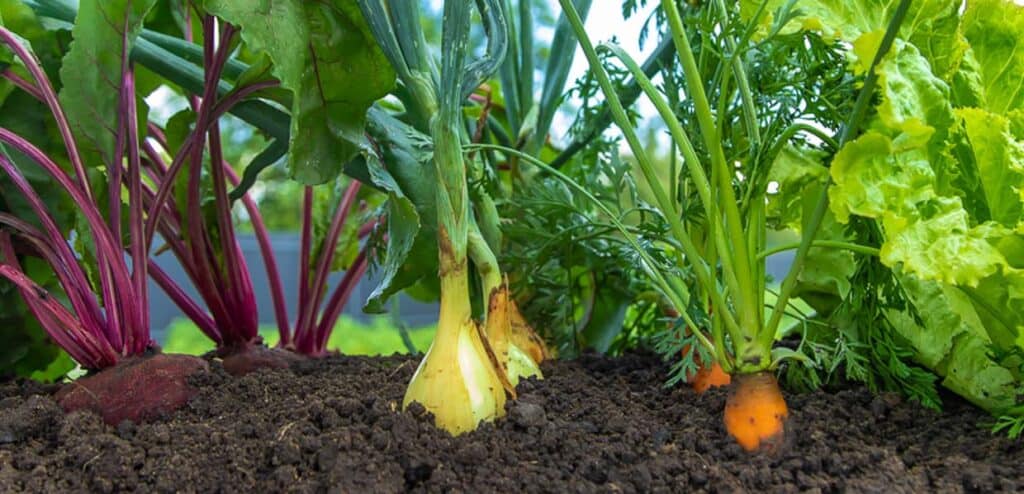Companion planting is a method of gardening that involves placing plants close together for mutual benefit. It’s a permaculture tactic and a practice as old as agriculture itself. Using this method can vastly improve your harvests while also protecting soil health.

The practice of companion planting is rooted in the understanding that certain plants can enhance the growth, flavor and health of nearby plants. By strategically pairing plants, gardeners can create an ecosystem that promotes biodiversity and sustainability.
Why we should practice companion planting
There are so many valuable reasons to practice this gardening technique. The top three benefits of companion plants include using less pesticides, growing better crops and its more eco-friendly to our planet.
Dan Morris, an accomplished gardener and author of Fire and Saw, says, “Companion planting is useful for various purposes. In our garden, we do it primarily for pest control, attracting pollinators, shade and nutrient sharing.”
Common companion plant combinations
There are a few popular companion plantings you can easily start using right away. Pick and choose from these popular combinations and increase your garden’s output.
Plant tomatoes together with basil and the basil will help repel insects and it’s believed to improve the flavor of tomatoes. Likewise, carrots and onions work well together because the smell of onions can deter carrot flies, while carrots are said to repel onion flies and aphids, making them a great pair. Another popular combination is bean plants and corn, the beans fix nitrogen in the soil, which benefits corn, while cornstalks provide a natural trellis for bean vines to climb.
Radishes can help repel cucumber beetles and other pests, so planting radishes and cucumbers together protects the cucumbers. Planting tall flowers like marigolds or nasturtiums with lettuce can provide shade for the lettuce, which prefers cooler temperatures and can help repel pests. Pigweed can lure away leafminers from pepper plants. Just be sure to remove the pigweed before it seeds.
Marigolds are known to repel nematodes and other garden pests, making them beneficial when planted near many vegetables. Nasturtiums can repel squash bugs and other pests, protecting squash plants.
Plant cabbage and dill together. The dill will attract beneficial wasps that prey on cabbage worms, offering natural protection for cabbage and related plants. When you plant borage together with strawberries it strengthens the resistance of strawberries to pests and disease and can improve their flavor.
By no means is that a complete list of beneficial companion planting options. There are many more to choose from. Often times a master gardener in your area can help you with more combinations for your specific needs.
What not to plant together
It is equally important while planning your plant companions to look into combinations of plants that don’t work well together. Sometimes plants from the same family can invite more disease to your gardens due to competition for resources, attraction of pests or negative chemical interactions. Some plants actively keep others from growing to the best of their ability, such as onions with beans.
Who should try this planting technique?
Anyone interested in gardening, from novices to experts, can benefit from companion planting. It’s especially appealing to those who value organic gardening, sustainability and creating a more diverse garden environment. Big or small, all crop sizes will benefit from companion planting.
If you love flowers in your garden, then just adding plants like calendulas and marigolds, to almost any garden is a great way to get started. They’re easy to grow from seeds, attract pollinators, and often repel soil pests as well.
When to companion plant
Companion planting can be implemented at any time during the planting season. It’s a principle that can be applied when you’re sowing seeds directly into the soil, and interplant those seeds around another beneficial seed. If you’re transplanting seedlings, add some plants from the list above. If you’re planning your garden layout, it’s a great time to add areas for beneficial plants to your plan this year.
Where can you companion plant
Companion planting is versatile and can be beneficial in gardens of any size. Whether you have a sprawling outdoor garden, a small backyard plot or even containers on a balcony or windowsill, integrating companion plants is almost always beneficial.
In essence, companion planting is a holistic approach to gardening that emphasizes the relationships between plants. It’s a practice that not only can lead to a healthier, more productive garden but also fosters a deeper connection with the natural world.
Laura Sampson of Little House Big Alaska is on a mission to teach modern family-oriented home cooks how to make old-fashioned foods new again. She shares her passion for home cooking, backyard gardening and homesteading on her website and blog.